
GenAI_Agents
This repository provides tutorials and implementations for various Generative AI Agent techniques, from basic to advanced. It serves as a comprehensive guide for building intelligent, interactive AI systems.
Stars: 10287
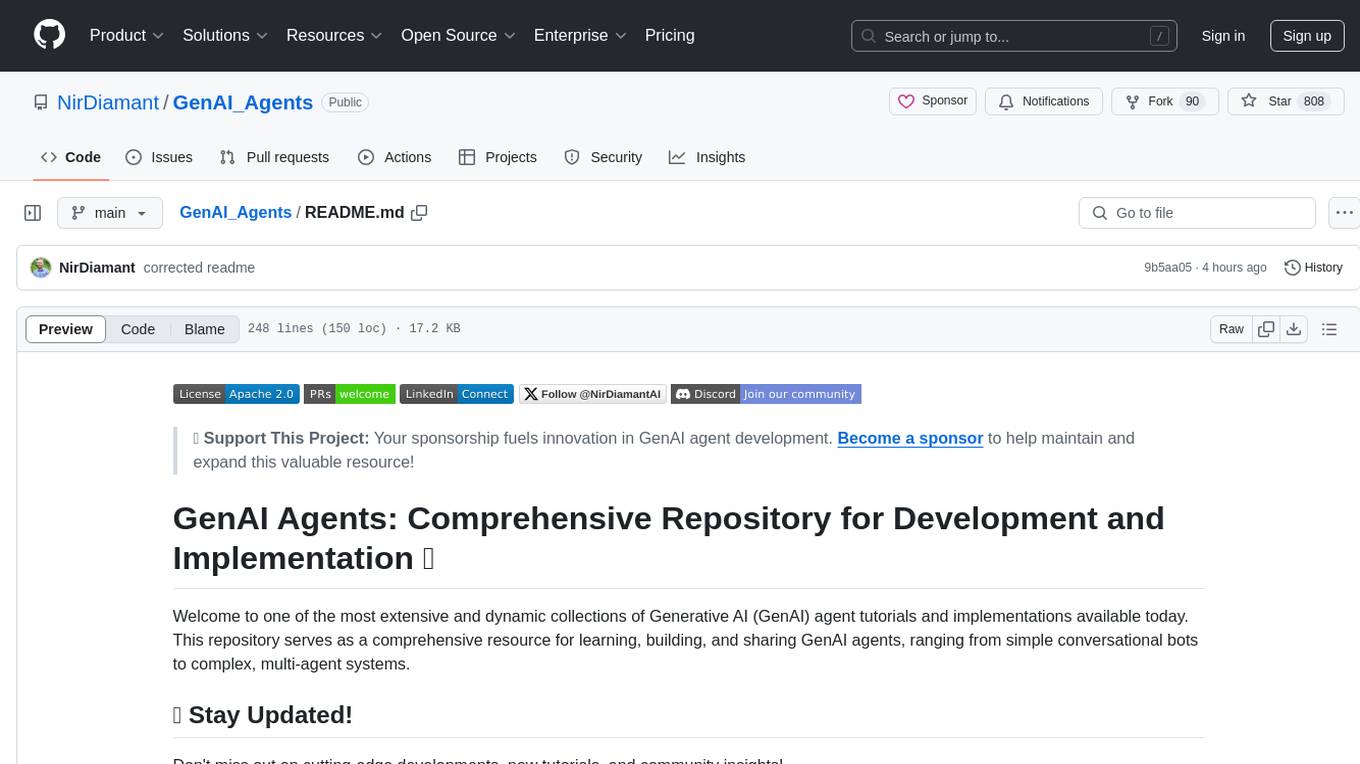
GenAI Agents is a comprehensive repository for developing and implementing Generative AI (GenAI) agents, ranging from simple conversational bots to complex multi-agent systems. It serves as a valuable resource for learning, building, and sharing GenAI agents, offering tutorials, implementations, and a platform for showcasing innovative agent creations. The repository covers a wide range of agent architectures and applications, providing step-by-step tutorials, ready-to-use implementations, and regular updates on advancements in GenAI technology.
README:
🌟 Support This Project: Your sponsorship fuels innovation in GenAI agent development. Become a sponsor to help maintain and expand this valuable resource!
Welcome to one of the most extensive and dynamic collections of Generative AI (GenAI) agent tutorials and implementations available today. This repository serves as a comprehensive resource for learning, building, and sharing GenAI agents, ranging from simple conversational bots to complex, multi-agent systems.
| 🚀 Cutting-edge Updates |
💡 Expert Insights |
🎯 Top 0.1% Content |
Join over 15,000 of AI enthusiasts getting unique cutting-edge insights and free tutorials! Plus, subscribers get exclusive early access and special 33% discounts to my book and the upcoming RAG Techniques course!
Generative AI agents are at the forefront of artificial intelligence, revolutionizing the way we interact with and leverage AI technologies. This repository is designed to guide you through the development journey, from basic agent implementations to advanced, cutting-edge systems.
|
Your First AI Agent: Simpler Than You Think This detailed blog post complements the repository by providing a complete A-Z walkthrough with in-depth explanations of core concepts, step-by-step implementation, and the theory behind AI agents. It's designed to be incredibly simple to follow while covering everything you need to know to build your first working agent from scratch. 💡 Plus: Subscribe to the newsletter for exclusive early access to tutorials and special discounts on upcoming courses and books! |
Our goal is to provide a valuable resource for everyone - from beginners taking their first steps in AI to seasoned practitioners pushing the boundaries of what's possible. By offering a range of examples from foundational to complex, we aim to facilitate learning, experimentation, and innovation in the rapidly evolving field of GenAI agents.
Furthermore, this repository serves as a platform for showcasing innovative agent creations. Whether you've developed a novel agent architecture or found an innovative application for existing techniques, we encourage you to share your work with the community.
📚 Dive into my comprehensive guide on RAG techniques to learn about integrating external knowledge into AI systems, enhancing their capabilities with up-to-date and relevant information retrieval.
🖋️ Explore my Prompt Engineering Techniques guide for an extensive collection of prompting strategies, from fundamental concepts to advanced methods, improving your ability to communicate effectively with AI language models.
This repository grows stronger with your contributions! Join our vibrant Discord community — the central hub for shaping and advancing this project together 🤝
GenAI Agents Discord Community
Whether you're a novice eager to learn or an expert ready to share your knowledge, your insights can shape the future of GenAI agents. Join us to propose ideas, get feedback, and collaborate on innovative implementations. For contribution guidelines, please refer to our CONTRIBUTING.md file. Let's advance GenAI agent technology together!
🔗 For discussions on GenAI, agents, or to explore knowledge-sharing opportunities, feel free to connect on LinkedIn.
- 🎓 Learn to build GenAI agents from beginner to advanced levels
- 🧠 Explore a wide range of agent architectures and applications
- 📚 Step-by-step tutorials and comprehensive documentation
- 🛠️ Practical, ready-to-use agent implementations
- 🌟 Regular updates with the latest advancements in GenAI
- 🤝 Share your own agent creations with the community
Explore our extensive list of GenAI agent implementations, sorted by categories:
-
Simple Conversational Agent
A context-aware conversational AI maintains information across interactions, enabling more natural dialogues.
Integrates a language model, prompt template, and history manager to generate contextual responses and track conversation sessions.
-
Simple Question Answering Agent
Answering (QA) agent using LangChain and OpenAI's language model understands user queries and provides relevant, concise answers.
Combines OpenAI's GPT model, a prompt template, and an LLMChain to process user questions and generate AI-driven responses in a streamlined manner.
-
Simple Data Analysis Agent
An AI-powered data analysis agent interprets and answers questions about datasets using natural language, combining language models with data manipulation tools for intuitive data exploration.
Integrates a language model, data manipulation framework, and agent framework to process natural language queries and perform data analysis on a synthetic dataset, enabling accessible insights for non-technical users.
-
Introduction to LangGraph: Building Modular AI Workflows
This tutorial introduces LangGraph, a powerful framework for creating modular, graph-based AI workflows. Learn how to leverage LangGraph to build more complex and flexible AI agents that can handle multi-step processes efficiently.
Step-by-step guide on using LangGraph to create a StateGraph workflow. The tutorial covers key concepts such as state management, node creation, and graph compilation. It demonstrates these principles by constructing a simple text analysis pipeline, serving as a foundation for more advanced agent architectures.
-
ATLAS: Academic Task and Learning Agent System
ATLAS demonstrates how to build an intelligent multi-agent system that transforms academic support through AI-powered assistance. The system leverages LangGraph's workflow framework to coordinate multiple specialized agents that provide personalized academic planning, note-taking, and advisory support.
Implements a state-managed multi-agent architecture using four specialized agents (Coordinator, Planner, Notewriter, and Advisor) working in concert through LangGraph's workflow framework. The system features sophisticated workflows for profile analysis and academic support, with continuous adaptation based on student performance and feedback.
-
Scientific Paper Agent - Literature Review
An intelligent research assistant that helps users navigate, understand, and analyze scientific literature through an orchestrated workflow. The system combines academic APIs with sophisticated paper processing techniques to automate literature review tasks, enabling researchers to efficiently extract insights from academic papers while maintaining research rigor and quality control.
Leverages LangGraph to create a five-node workflow system including decision making, planning, tool execution, and quality validation nodes. The system integrates the CORE API for paper access, PDFplumber for document processing, and advanced language models for analysis. Key features include a retry mechanism for robust paper downloads, structured data handling through Pydantic models, and quality-focused improvement cycles with human-in-the-loop validation options.
-
Chiron - A Feynman-Enhanced Learning Agent
An adaptive learning agent that guides users through educational content using a structured checkpoint system and Feynman-style teaching. The system processes learning materials (either user-provided or web-retrieved), verifies understanding through interactive checkpoints, and provides simplified explanations when needed, creating a personalized learning experience that mimics one-on-one tutoring.
Uses LangGraph to orchestrate a learning workflow that includes checkpoint definition, context building, understanding verification, and Feynman teaching nodes. The system integrates web search for dynamic content retrieval, employs semantic chunking for context processing, and manages embeddings for relevant information retrieval. Key features include a 70% understanding threshold for progression, interactive human-in-the-loop validation, and structured output through Pydantic models for consistent data handling.
-
Customer Support Agent (LangGraph)
An intelligent customer support agent using LangGraph categorizes queries, analyzes sentiment, and provides appropriate responses or escalates issues.
Utilizes LangGraph to create a workflow combining state management, query categorization, sentiment analysis, and response generation.
-
Essay Grading Agent (LangGraph)
An automated essay grading system using LangGraph and an LLM model evaluates essays based on relevance, grammar, structure, and depth of analysis.
Utilizes a state graph to define the grading workflow, incorporating separate grading functions for each criterion.
-
Travel Planning Agent (LangGraph)
A Travel Planner using LangGraph demonstrates how to build a stateful, multi-step conversational AI application that collects user input and generates personalized travel itineraries.
Utilizes StateGraph to define the application flow, incorporates custom PlannerState for process management.
-
The GenAI Career Assistant demonstrates how to create a multi-agent system that provides personalized guidance for careers in Generative AI. Using LangGraph and Gemini LLM, the system delivers customized learning paths, resume assistance, interview preparation, and job search support.
Leverages a multi-agent architecture using LangGraph to coordinate specialized agents (Learning, Resume, Interview, Job Search) through TypedDict-based state management. The system employs sophisticated query categorization and routing while integrating with external tools like DuckDuckGo for job searches and dynamic content generation.
-
Project Manager Assistant Agent
An AI agent designed to assist in project management tasks by automating the process of creating actionable tasks from project descriptions, identifying dependencies, scheduling work, and assigning tasks to team members based on expertise. The system includes risk assessment and self-reflection capabilities to optimize project plans through multiple iterations, aiming to minimize overall project risk.
Leverages LangGraph to orchestrate a workflow of specialized nodes including task generation, dependency mapping, scheduling, allocation, and risk assessment. Each node uses GPT-4o-mini for structured outputs following Pydantic models. The system implements a feedback loop for self-improvement, where risk scores trigger reflection cycles that generate insights to optimize the project plan. Visualization tools display Gantt charts of the generated schedules across iterations.
-
Contract Analysis Assistant (ClauseAI)
ClauseAI demonstrates how to build an AI-powered contract analysis system using a multi-agent approach. The system employs specialized AI agents for different aspects of contract review, from clause analysis to compliance checking, and leverages LangGraph for workflow orchestration and Pinecone for efficient clause retrieval and comparison.
Implements a sophisticated state-based workflow using LangGraph to coordinate multiple AI agents through contract analysis stages. The system features Pydantic models for data validation, vector storage with Pinecone for clause comparison, and LLM-based analysis for generating comprehensive contract reports. The implementation includes parallel processing capabilities and customizable report generation based on user requirements.
-
The E2E Testing Agent demonstrates how to build an AI-powered system that converts natural language test instructions into executable end-to-end web tests. Using LangGraph for workflow orchestration and Playwright for browser automation, the system enables users to specify test cases in plain English while handling the complexity of test generation and execution.
Implements a structured workflow using LangGraph to coordinate test generation, validation, and execution. The system features TypedDict state management, integration with Playwright for browser automation, and LLM-based code generation for converting natural language instructions into executable test scripts. The implementation includes DOM state analysis, error handling, and comprehensive test reporting.
-
GIF Animation Generator Agent (LangGraph)
A GIF animation generator that integrates LangGraph for workflow management, GPT-4 for text generation, and DALL-E for image creation, producing custom animations from user prompts.
Utilizes LangGraph to orchestrate a workflow that generates character descriptions, plots, and image prompts using GPT-4, creates images with DALL-E 3, and assembles them into GIFs using PIL. Employs asynchronous programming for efficient parallel processing.
-
TTS Poem Generator Agent (LangGraph)
An advanced text-to-speech (TTS) agent using LangGraph and OpenAI's APIs classifies input text, processes it based on content type, and generates corresponding speech output.
Utilizes LangGraph to orchestrate a workflow that classifies input text using GPT models, applies content-specific processing, and converts the processed text to speech using OpenAI's TTS API. The system adapts its output based on the identified content type (general, poem, news, or joke).
-
Music Compositor Agent (LangGraph)
An AI Music Compositor using LangGraph and OpenAI's language models generates custom musical compositions based on user input. The system processes the input through specialized components, each contributing to the final musical piece, which is then converted to a playable MIDI file.
LangGraph orchestrates a workflow that transforms user input into a musical composition, using ChatOpenAI (GPT-4) to generate melody, harmony, and rhythm, which are then style-adapted. The final AI-generated composition is converted to a MIDI file using music21 and can be played back using pygame.
-
Content Intelligence: Multi-Platform Content Generation Agent
Content Intelligence demonstrates how to build an advanced content generation system that transforms input text into platform-optimized content across multiple social media channels. The system employs LangGraph for workflow orchestration to analyze content, conduct research, and generate tailored content while maintaining brand consistency across different platforms.
Implements a sophisticated workflow using LangGraph to coordinate multiple specialized nodes (Summary, Research, Platform-Specific) through the content generation process. The system features TypedDict and Pydantic models for state management, integration with Tavily Search for research enhancement, and platform-specific content generation using GPT-4. The implementation includes parallel processing for multiple platforms and customizable content templates.
-
Business Meme Generator Using LangGraph and Memegen.link
The Business Meme Generator demonstrates how to create an AI-powered system that generates contextually relevant memes based on company website analysis. Using LangGraph for workflow orchestration, the system combines Groq's Llama model for text analysis and the Memegen.link API to automatically produce brand-aligned memes for digital marketing.
Implements a state-managed workflow using LangGraph to coordinate website content analysis, meme concept generation, and image creation. The system features Pydantic models for data validation, asynchronous processing with aiohttp, and integration with external APIs (Groq, Memegen.link) to create a complete meme generation pipeline with customizable templates.
-
Murder Mystery Game with LLM Agents
A text-based detective game that utilizes autonomous LLM agents as interactive characters in a procedurally generated murder mystery. Drawing inspiration from the UNBOUNDED paper, the system creates unique scenarios each time, with players taking on the role of Sherlock Holmes to solve the case through character interviews and deductive reasoning.
Leverages two LangGraph workflows - a main game loop for story/character generation and game progression, and a conversation sub-graph for character interactions. The system uses a combination of LLM-powered narrative generation, character AI, and structured game mechanics to create an immersive investigative experience with replayable storylines.
-
Memory-Enhanced Conversational Agent
A memory-enhanced conversational AI agent incorporates short-term and long-term memory systems to maintain context within conversations and across multiple sessions, improving interaction quality and personalization.
Integrates a language model with separate short-term and long-term memory stores, utilizes a prompt template incorporating both memory types, and employs a memory manager for storage and retrieval. The system includes an interaction loop that updates and utilizes memories for each response.
-
Multi-Agent Collaboration System
A multi-agent collaboration system combining historical research with data analysis, leveraging large language models to simulate specialized agents working together to answer complex historical questions.
Utilizes a base Agent class to create specialized HistoryResearchAgent and DataAnalysisAgent, orchestrated by a HistoryDataCollaborationSystem. The system follows a five-step process: historical context provision, data needs identification, historical data provision, data analysis, and final synthesis.
-
A Self-Improving Agent using LangChain engages in conversations, learns from interactions, and continuously improves its performance over time through reflection and adaptation.
Integrates a language model with chat history management, response generation, and a reflection mechanism. The system employs a learning system that incorporates insights from reflection to enhance future performance, creating a continuous improvement loop.
-
A language model application using LangChain that summarizes text and translates the summary to Spanish, combining custom functions, structured tools, and an agent for efficient text processing.
Utilizes custom functions for summarization and translation, wrapped as structured tools. Employs a prompt template to guide the agent, which orchestrates the use of tools. An agent executor manages the process, taking input text and producing both an English summary and its Spanish translation.
-
Internet Search and Summarize Agent
An intelligent web research assistant that combines web search capabilities with AI-powered summarization, automating the process of gathering information from the internet and distilling it into concise, relevant summaries.
Integrates a web search module using DuckDuckGo's API, a result parser, and a text summarization engine leveraging OpenAI's language models. The system performs site-specific or general searches, extracts relevant content, generates concise summaries, and compiles attributed results for efficient information retrieval and synthesis.
-
Multi agent research team - Autogen
This technique explores a multi-agent system for collaborative research using the AutoGen library. It employs agents to solve tasks collaboratively, focusing on efficient execution and quality assurance. The system enhances research by distributing tasks among specialized agents.
Agents are configured with specific roles using the GPT-4 model, including admin, developer, planner, executor, and quality assurance. Interaction management ensures orderly communication with defined transitions. Task execution involves collaborative planning, coding, execution, and quality checking, demonstrating a scalable framework for various domains.
-
An intelligent system that automates the analysis of sales call recordings by combining audio transcription with advanced natural language processing. The analyzer transcribes audio using OpenAI's Whisper, processes the text using NLP techniques, and generates comprehensive reports including sentiment analysis, key phrases, pain points, and actionable recommendations to improve sales performance.
Utilizes multiple components in a structured workflow: OpenAI Whisper for audio transcription, CrewAI for task automation and agent management, and LangChain for orchestrating the analysis pipeline. The system processes audio through a series of steps from transcription to detailed analysis, leveraging custom agents and tasks to generate structured JSON reports containing insights about customer sentiment, sales opportunities, and recommended improvements.
-
Weather Emergency & Response System
A comprehensive system demonstrating two agent graph implementations for weather emergency response: a real-time graph processing live weather data, and a hybrid graph combining real and simulated data for testing high-severity scenarios. The system handles complete workflow from data gathering through emergency plan generation, with automated notifications and human verification steps.
Utilizes LangGraph for orchestrating complex workflows with state management, integrating OpenWeatherMap API for real-time data, and Gemini for analysis and response generation. The system incorporates email notifications, social media monitoring simulation, and severity-based routing with configurable human verification for low/medium severity events.
-
An intelligent system that automatically detects, diagnoses, and fixes runtime code errors using LangGraph workflow orchestration and ChromaDB vector storage. The system maintains a memory of encountered bugs and their fixes through vector embeddings, enabling pattern recognition for similar errors across the codebase.
Utilizes a state-based graph workflow that processes function definitions and runtime arguments through specialized nodes for error detection, code analysis, and fix generation. Incorporates ChromaDB for vector-based storage of bug patterns and fixes, with automated search and retrieval capabilities for similar error patterns, while maintaining code execution safety through structured validation steps.
-
DataScribe: AI-Powered Schema Explorer
An intelligent agent system that enables intuitive exploration and querying of relational databases through natural language interactions. The system utilizes a fleet of specialized agents, coordinated by a stateful Supervisor, to handle schema discovery, query planning, and data analysis tasks while maintaining contextual understanding through vector-based relationship graphs.
Leverages LangGraph for orchestrating a multi-agent workflow including discovery, inference, and planning agents, with NetworkX for relationship graph visualization and management. The system incorporates dynamic state management through TypedDict classes, maintains database context between sessions using a db_graph attribute, and includes safety measures to prevent unauthorized database modifications.
-
Memory-Enhanced Email Agent (LangGraph & LangMem)
An intelligent email assistant that combines three types of memory (semantic, episodic, and procedural) to create a system that improves over time. The agent can triage incoming emails, draft contextually appropriate responses using stored knowledge, and enhance its performance based on user feedback.
Leverages LangGraph for workflow orchestration and LangMem for sophisticated memory management across multiple memory types. The system implements a triage workflow with memory-enhanced decision making, specialized tools for email composition and calendar management, and a self-improvement mechanism that updates its own prompts based on feedback and past performance.
-
A news summarization system that generates concise TL;DR summaries of current events based on user queries. The system leverages large language models for decision making and summarization while integrating with news APIs to access up-to-date content, allowing users to quickly catch up on topics of interest through generated bullet-point summaries.
Utilizes LangGraph to orchestrate a workflow combining multiple components: GPT-4o-mini for generating search terms and article summaries, NewsAPI for retrieving article metadata, BeautifulSoup for web scraping article content, and Asyncio for concurrent processing. The system follows a structured pipeline from query processing through article selection and summarization, managing the flow between components to produce relevant TL;DRs of current news articles.
-
AInsight: AI/ML Weekly News Reporter
AInsight demonstrates how to build an intelligent news aggregation and summarization system using a multi-agent architecture. The system employs three specialized agents (NewsSearcher, Summarizer, Publisher) to automatically collect, process and summarize AI/ML news for general audiences through LangGraph-based workflow orchestration.
Implements a state-managed multi-agent system using LangGraph to coordinate the news collection (Tavily API), technical content summarization (GPT-4), and report generation processes. The system features modular architecture with TypedDict-based state management, external API integration, and markdown report generation with customizable templates.
-
Journalism-Focused AI Assistant
A specialized AI assistant that helps journalists tackle modern journalistic challenges like misinformation, bias, and information overload. The system integrates fact-checking, tone analysis, summarization, and grammar review tools to enhance the accuracy and efficiency of journalistic work while maintaining ethical reporting standards.
Leverages LangGraph to orchestrate a workflow of specialized components including language models for analysis and generation, web search integration via DuckDuckGo's API, document parsing tools like PyMuPDFLoader and WebBaseLoader, text splitting with RecursiveCharacterTextSplitter, and structured JSON outputs. Each component works together through a unified workflow to analyze content, verify facts, detect bias, extract quotes, and generate comprehensive reports.
-
A multi-agent system for collaborative blog post creation using OpenAI's Swarm package. It leverages specialized agents to perform research, planning, writing, and editing tasks efficiently.
Utilizes OpenAI's Swarm Package to manage agent interactions. Includes an admin, researcher, planner, writer, and editor, each with specific roles. The system follows a structured workflow: topic setting, outlining, research, drafting, and editing. This approach enhances content creation through task distribution, specialization, and collaborative problem-solving.
-
Podcast Internet Search and Generate Agent 🎙️
A two step agent that first searches the internet for a given topic and then generates a podcast on the topic found. The search step uses a search agent and search function to find the most relevant information. The second step uses a podcast generation agent and generation function to create a podcast on the topic found.
Utilizes LangGraph to orchestrate a two-step workflow. The first step involves a search agent and function to gather information from the internet. The second step uses a podcast generation agent and function to create a podcast based on the gathered information.
-
ShopGenie - Redefining Online Shopping Customer Experience
An AI-powered shopping assistant that helps customers make informed purchasing decisions even without domain expertise. The system analyzes product information from multiple sources, compares specifications and reviews, identifies the best option based on user needs, and delivers recommendations through email with supporting video reviews, creating a comprehensive shopping experience.
Uses LangGraph to orchestrate a workflow combining Tavily for web search, Llama-3.1-70B for structured data analysis and product comparison, and YouTube API for review video retrieval. The system processes search results through multiple nodes including schema mapping, product comparison, review identification, and email generation. Key features include structured Pydantic models for consistent data handling, retry mechanisms for robust API interactions, and email delivery through SMTP for sharing recommendations.
-
The Smart Product Buyer AI Agent demonstrates how to build an intelligent system that assists users in making informed purchasing decisions. Using LangGraph and LLM-based intelligence, the system processes user requirements, scrapes product listings from websites like AutoTrader, and provides detailed analysis and recommendations for car purchases.
Implements a state-based workflow using LangGraph to coordinate user interaction, web scraping, and decision support. The system features TypedDict state management, async web scraping with Playwright, and integrates with external APIs for comprehensive product analysis. The implementation includes a Gradio interface for real-time chat interaction and modular scraper architecture for easy extension to additional product categories.
-
Taskifier - Intelligent Task Allocation & Management
An intelligent task management system that analyzes user work styles and creates personalized task breakdown strategies, born from the observation that procrastination often stems from task ambiguity among students and early-career professionals. The system evaluates historical work patterns, gathers relevant task information through web search, and generates customized step-by-step approaches to optimize productivity and reduce workflow paralysis.
Leverages LangGraph for orchestrating a multi-step workflow including work style analysis, information gathering via Tavily API, and customized plan generation. The system maintains state through the process, integrating historical work pattern data with fresh task research to output detailed, personalized task execution plans aligned with the user's natural working style.
-
Grocery Management Agents System
A multi-agent system built with CrewAI that automates grocery management tasks including receipt interpretation, expiration date tracking, inventory management, and recipe recommendations. The system uses specialized agents to extract data from receipts, estimate product shelf life, track consumption, and suggest recipes to minimize food waste.
Implements four specialized agents using CrewAI - a Receipt Interpreter that extracts item details from receipts, an Expiration Date Estimator that determines shelf life using online sources, a Grocery Tracker that maintains inventory based on consumption, and a Recipe Recommender that suggests meals using available ingredients. Each agent has specific tools and tasks orchestrated through a crew workflow.
-
LangGraph-Based Systems Inspector
A comprehensive testing and validation tool for LangGraph-based applications that automatically analyzes system architecture, generates test cases, and identifies potential vulnerabilities through multi-agent inspection. The inspector employs specialized AI testers to evaluate different aspects of the system, from basic functionality to security concerns and edge cases.
Integrates LangGraph for workflow orchestration, multiple LLM-powered testing agents, and a structured evaluation pipeline that includes static analysis, test case generation, and results verification. The system uses Pydantic for data validation, NetworkX for graph representation, and implements a modular architecture that allows for parallel test execution and comprehensive result analysis.
-
The EU Green Deal FAQ Bot demonstrates how to build a RAG-based AI agent that helps businesses understand EU green deal policies. The system processes complex regulatory documents into manageable chunks and provides instant, accurate answers to common questions about environmental compliance, emissions reporting, and waste management requirements.
Implements a sophisticated RAG pipeline using FAISS vectorstore for document storage, semantic chunking for preprocessing, and multiple specialized agents (Retriever, Summarizer, Evaluator) for query processing. The system features query rephrasing for improved accuracy, cross-reference with gold Q&A datasets for answer validation, and comprehensive evaluation metrics to ensure response quality and relevance.
-
Systematic Review Automation System + Paper Draft Creation
A comprehensive system for automating academic systematic reviews using a directed graph architecture and LangChain components. The system generates complete, publication-ready systematic review papers, automatically processing everything from literature search through final draft generation with multiple revision cycles.
Utilizes a state-based graph workflow that handles paper search and selection (up to 3 papers), PDF processing, and generates a complete academic paper with all standard sections (abstract, introduction, methods, results, conclusions, references). The system incorporates multiple revision cycles with automated critique and improvement phases, all orchestrated through LangGraph state management.
-
Sophisticated Controllable Agent for Complex RAG Tasks 🤖
An advanced RAG solution designed to tackle complex questions that simple semantic similarity-based retrieval cannot solve. This approach uses a sophisticated deterministic graph as the "brain" 🧠 of a highly controllable autonomous agent, capable of answering non-trivial questions from your own data.
• Implement a multi-step process involving question anonymization, high-level planning, task breakdown, adaptive information retrieval and question answering, continuous re-planning, and rigorous answer verification to ensure grounded and accurate responses.
To begin exploring and building GenAI agents:
- Clone this repository:
git clone https://github.com/NirDiamant/GenAI_Agents.git - Navigate to the technique you're interested in:
cd all_agents_tutorials/technique-name - Follow the detailed implementation guide in each technique's notebook.
We welcome contributions from the community! If you have a new technique or improvement to suggest:
- Fork the repository
- Create your feature branch:
git checkout -b feature/AmazingFeature - Commit your changes:
git commit -m 'Add some AmazingFeature' - Push to the branch:
git push origin feature/AmazingFeature - Open a pull request
This project is licensed under a custom non-commercial license - see the LICENSE file for details.
⭐️ If you find this repository helpful, please consider giving it a star!
Keywords: GenAI, Generative AI, Agents, NLP, AI, Machine Learning, Natural Language Processing, LLM, Conversational AI, Task-Oriented AI
For Tasks:
Click tags to check more tools for each tasksFor Jobs:
Alternative AI tools for GenAI_Agents
Similar Open Source Tools

GenAI_Agents
GenAI Agents is a comprehensive repository for developing and implementing Generative AI (GenAI) agents, ranging from simple conversational bots to complex multi-agent systems. It serves as a valuable resource for learning, building, and sharing GenAI agents, offering tutorials, implementations, and a platform for showcasing innovative agent creations. The repository covers a wide range of agent architectures and applications, providing step-by-step tutorials, ready-to-use implementations, and regular updates on advancements in GenAI technology.
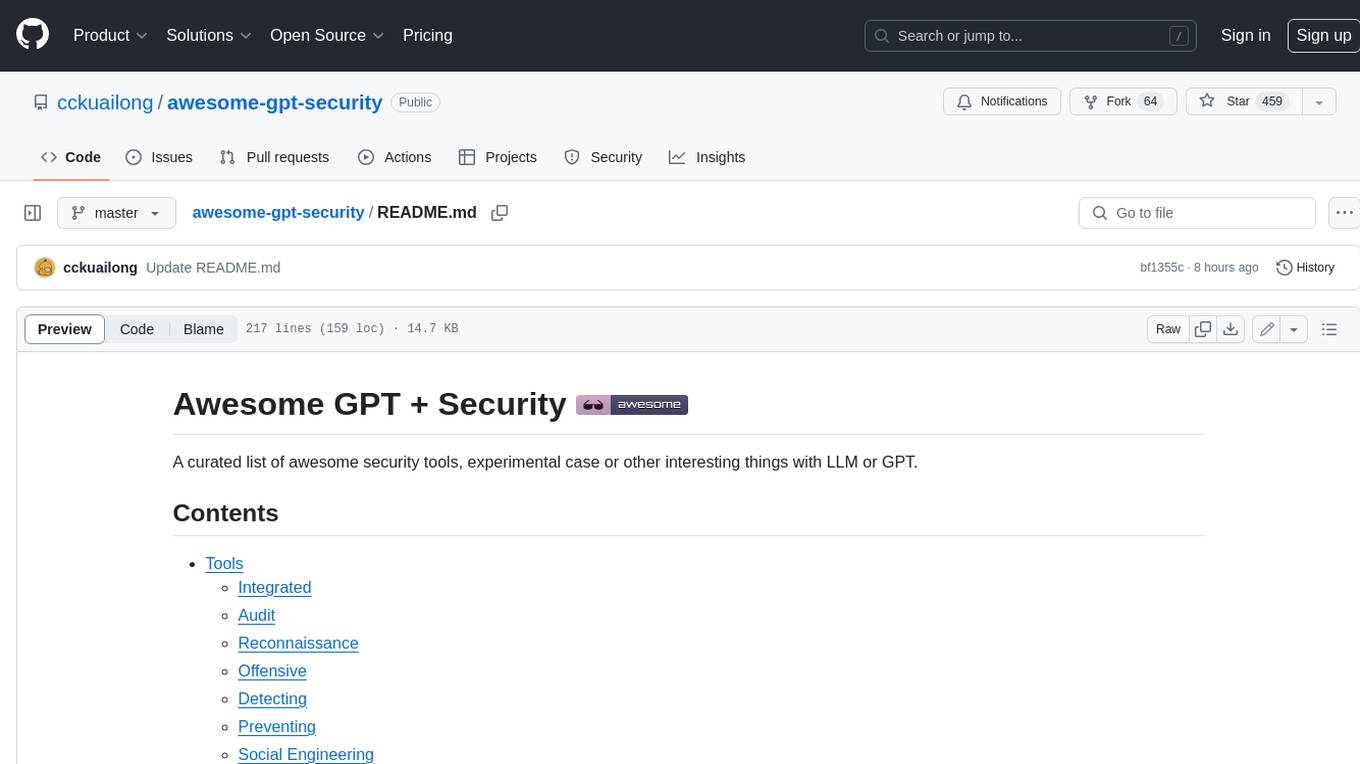
awesome-gpt-security
Awesome GPT + Security is a curated list of awesome security tools, experimental case or other interesting things with LLM or GPT. It includes tools for integrated security, auditing, reconnaissance, offensive security, detecting security issues, preventing security breaches, social engineering, reverse engineering, investigating security incidents, fixing security vulnerabilities, assessing security posture, and more. The list also includes experimental cases, academic research, blogs, and fun projects related to GPT security. Additionally, it provides resources on GPT security standards, bypassing security policies, bug bounty programs, cracking GPT APIs, and plugin security.
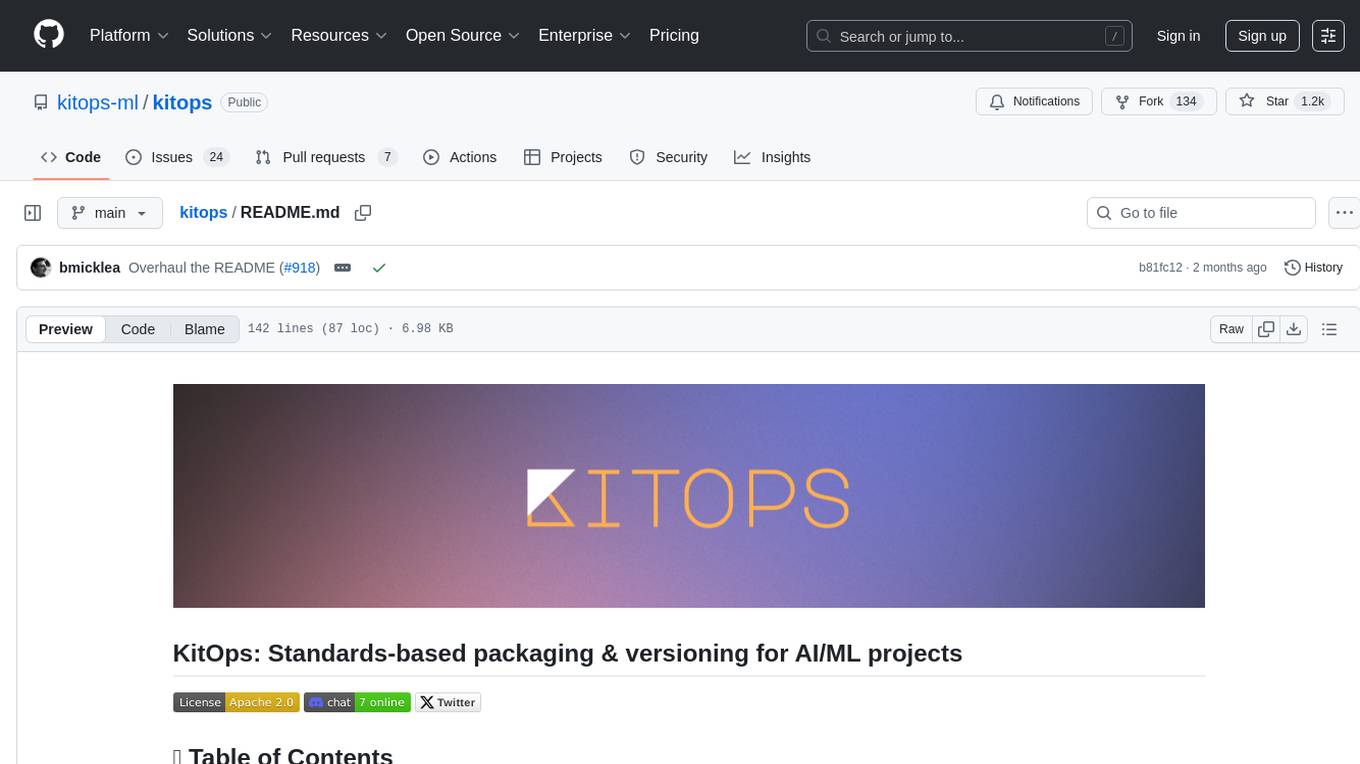
kitops
KitOps is a CNCF open standards project for packaging, versioning, and securely sharing AI/ML projects. It provides a unified solution for packaging, versioning, and managing assets in security-conscious enterprises, governments, and cloud operators. KitOps elevates AI artifacts to first-class, governed assets through ModelKits, which are tamper-proof, signable, and compatible with major container registries. The tool simplifies collaboration between data scientists, developers, and SREs, ensuring reliable and repeatable workflows for both development and operations. KitOps supports packaging for various types of models, including large language models, computer vision models, multi-modal models, predictive models, and audio models. It also facilitates compliance with the EU AI Act by offering tamper-proof, signable, and auditable ModelKits.
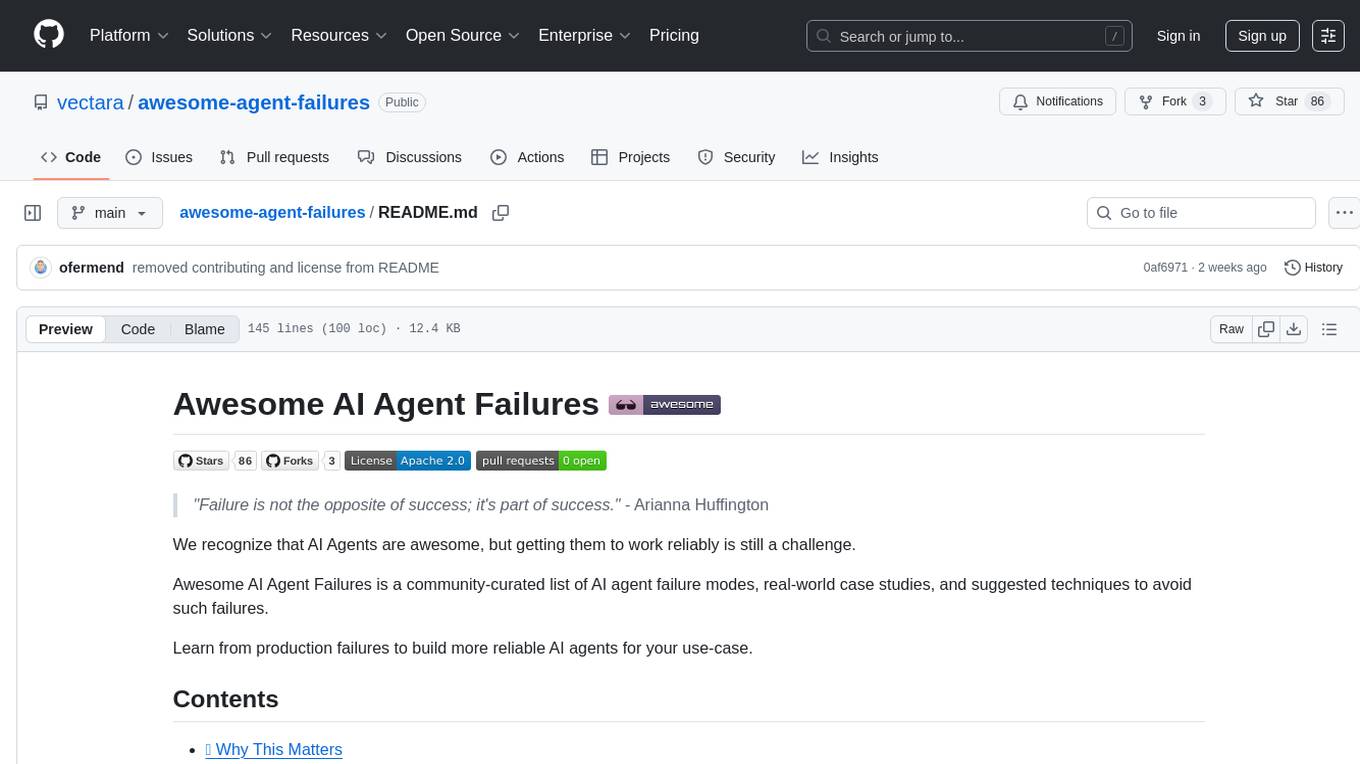
awesome-agent-failures
Awesome AI Agent Failures is a community-curated repository documenting known failure modes for AI agents, real-world case studies, and techniques to avoid failures. It provides insights into common failure modes such as tool hallucination, response hallucination, goal misinterpretation, plan generation failures, incorrect tool use, verification & termination failures, and prompt injection. The repository also includes resources like research papers, industry resources, books, external resources, and related awesome lists to help AI engineers build more reliable AI agents by learning from production failures.
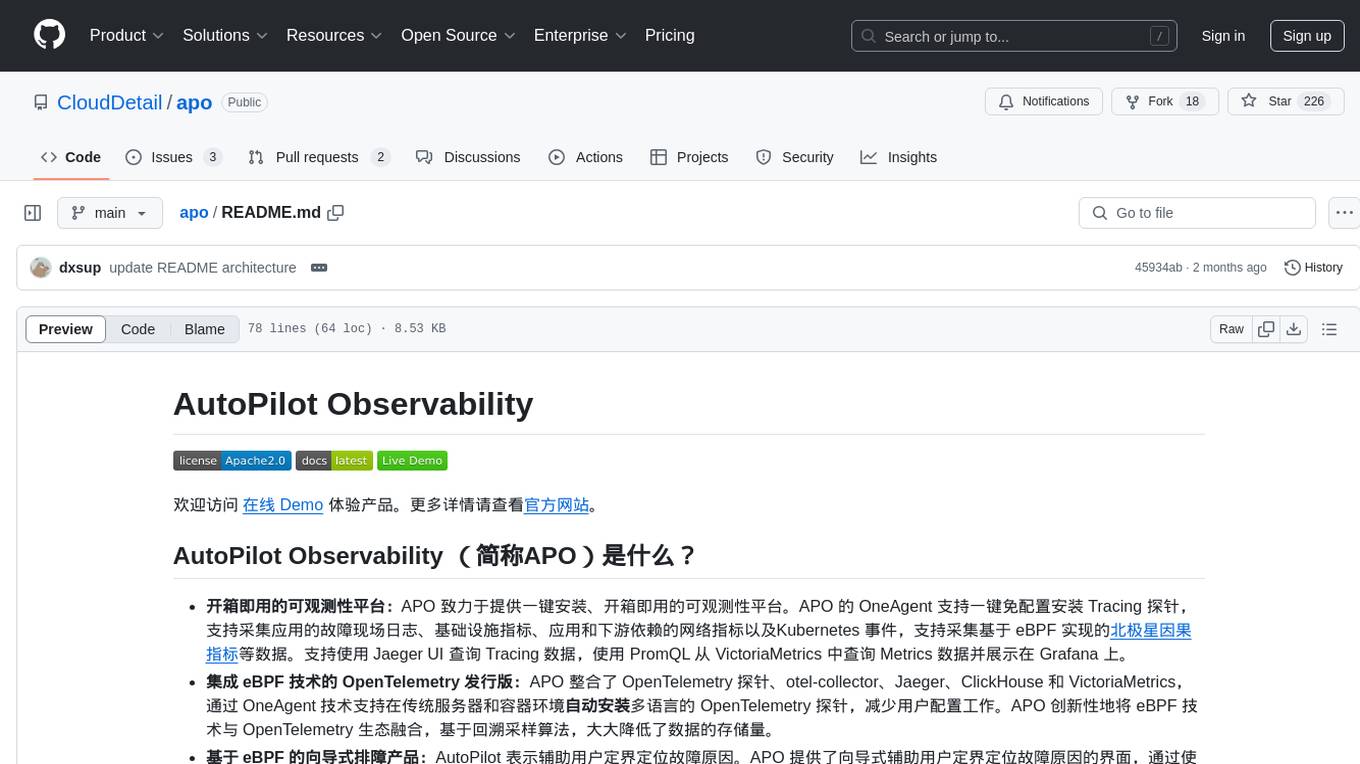
apo
AutoPilot Observability (APO) is an out-of-the-box observability platform that provides one-click installation and ready-to-use capabilities. APO's OneAgent supports one-click configuration-free installation of Tracing probes, collects application fault scene logs, infrastructure metrics, network metrics of applications and downstream dependencies, and Kubernetes events. It supports collecting causality metrics based on eBPF implementation. APO integrates OpenTelemetry probes, otel-collector, Jaeger, ClickHouse, and VictoriaMetrics, reducing user configuration work. APO innovatively integrates eBPF technology with the OpenTelemetry ecosystem, significantly reducing data storage volume. It offers guided troubleshooting using eBPF technology to assist users in pinpointing fault causes on a single page.
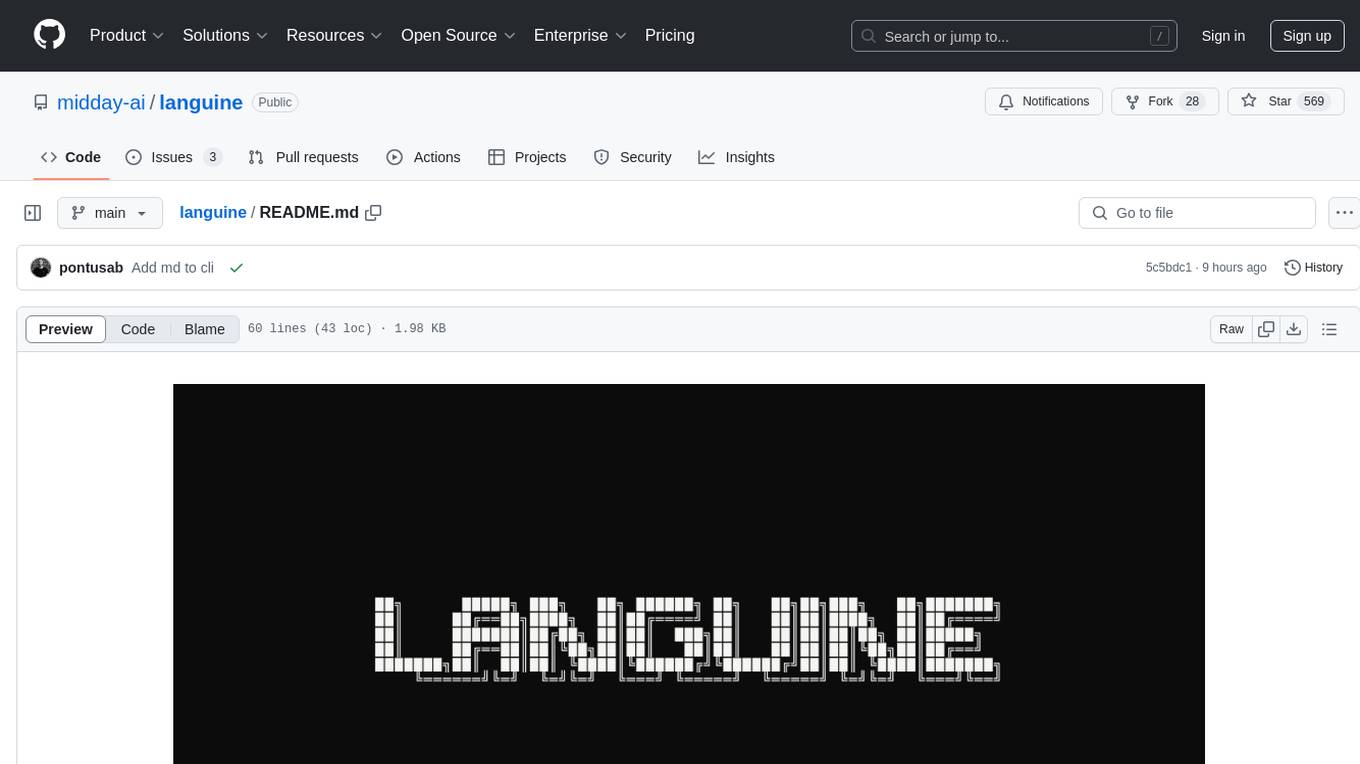
languine
Languine is a CLI tool that helps developers streamline the localization process by providing AI-powered translations, automation features, and developer-centric design. It allows users to easily manage translation files, maintain consistency in tone and style, and save time by automating tasks. With support for over 100 languages and smart detection capabilities, Languine simplifies the localization workflow for developers.
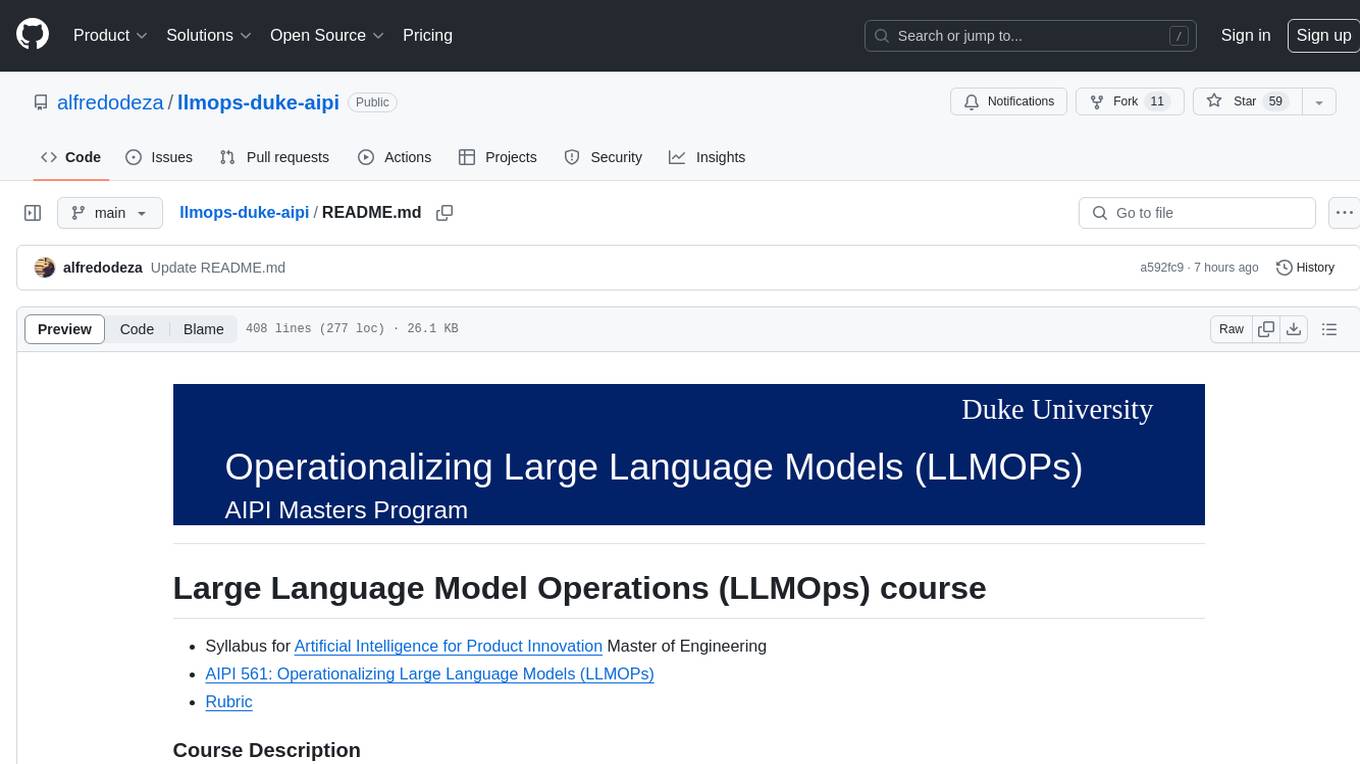
llmops-duke-aipi
LLMOps Duke AIPI is a course focused on operationalizing Large Language Models, teaching methodologies for developing applications using software development best practices with large language models. The course covers various topics such as generative AI concepts, setting up development environments, interacting with large language models, using local large language models, applied solutions with LLMs, extensibility using plugins and functions, retrieval augmented generation, introduction to Python web frameworks for APIs, DevOps principles, deploying machine learning APIs, LLM platforms, and final presentations. Students will learn to build, share, and present portfolios using Github, YouTube, and Linkedin, as well as develop non-linear life-long learning skills. Prerequisites include basic Linux and programming skills, with coursework available in Python or Rust. Additional resources and references are provided for further learning and exploration.
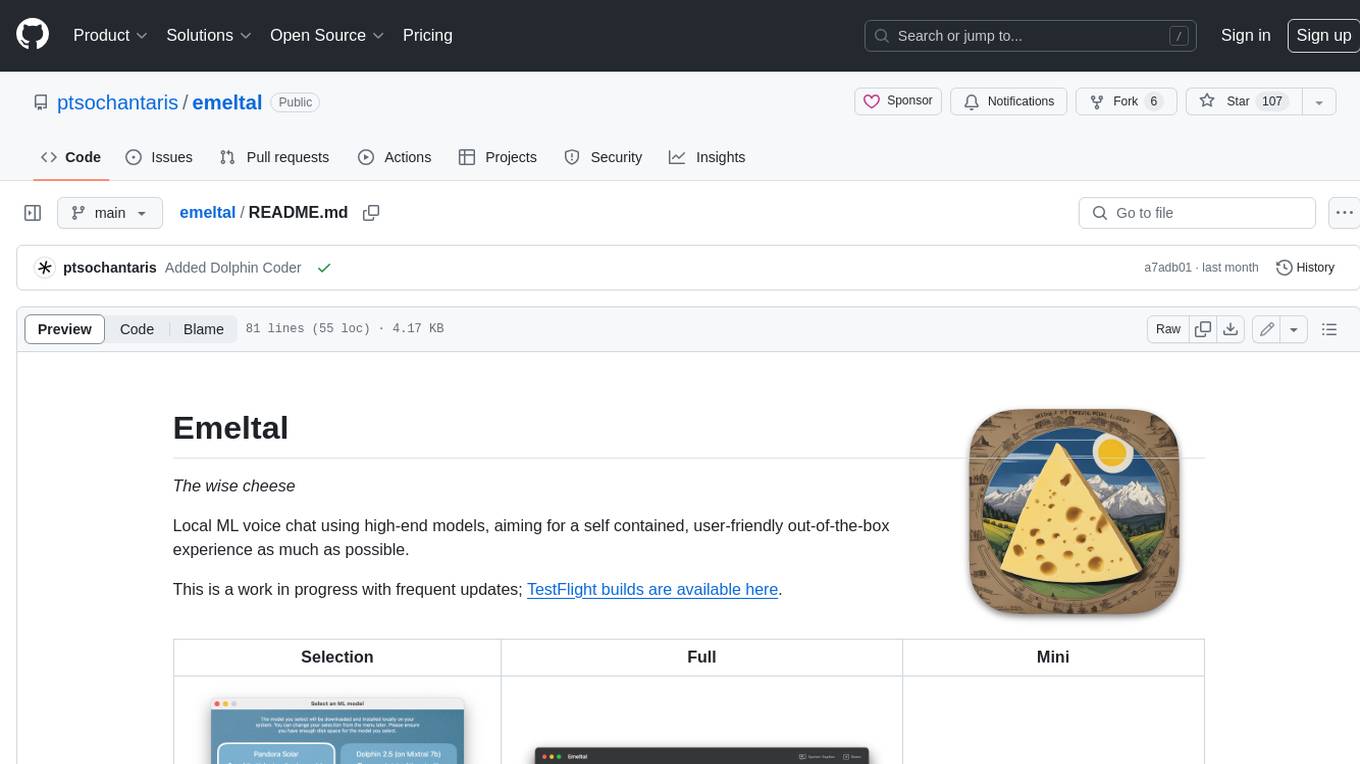
emeltal
Emeltal is a local ML voice chat tool that uses high-end models to provide a self-contained, user-friendly out-of-the-box experience. It offers a hand-picked list of proven open-source high-performance models, aiming to provide the best model for each category/size combination. Emeltal heavily relies on the llama.cpp for LLM processing, and whisper.cpp for voice recognition. Text rendering uses Ink to convert between Markdown and HTML. It uses PopTimer for debouncing things. Emeltal is released under the terms of the MIT license, and all model data which is downloaded locally by the app comes from HuggingFace, and use of the models and data is subject to the respective license of each specific model.
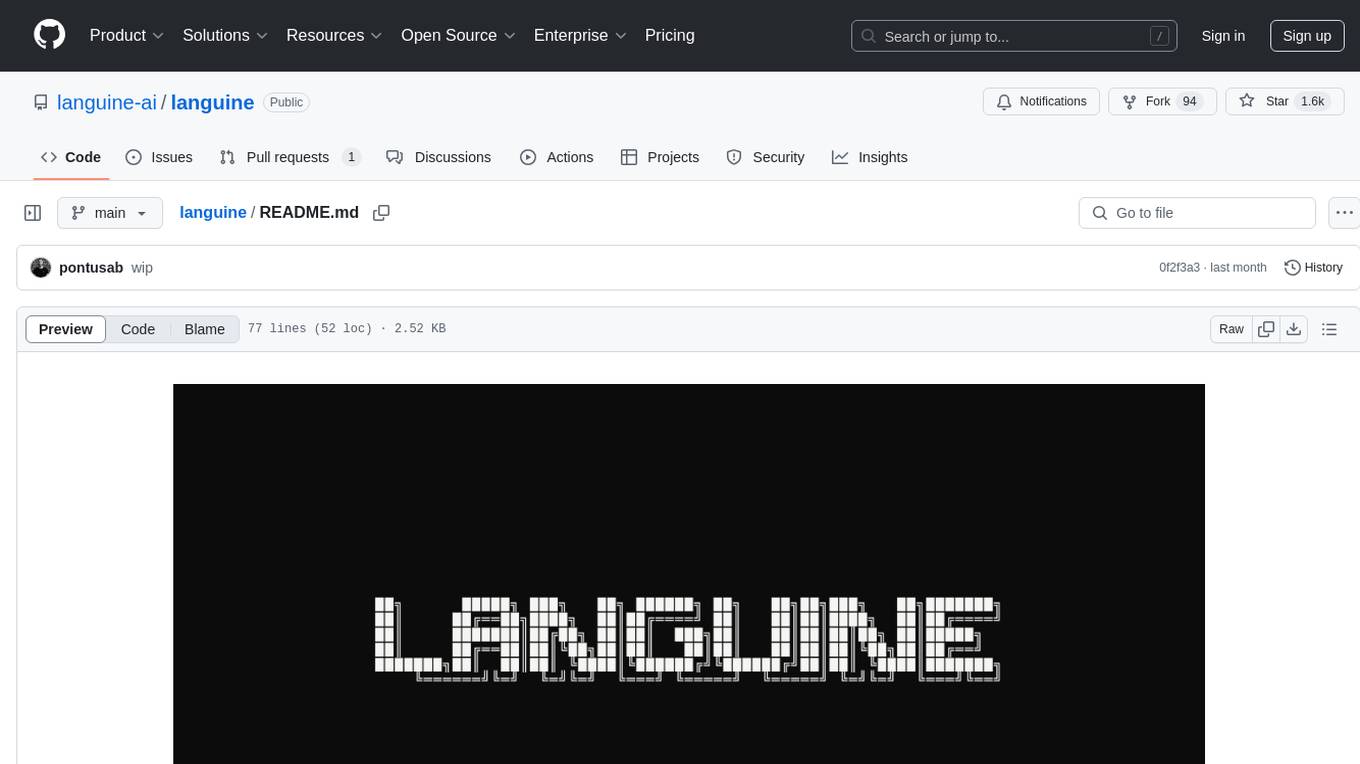
languine
Languine is a CLI tool powered by AI that helps developers streamline the localization process by providing AI-powered translations, automation features, consistent localization, developer-centric design, and time-saving workflows. It automates the identification of translation keys, supports multiple file formats, delivers accurate translations in over 100 languages, aligns translations with the original text's tone and intent, extracts translation keys from codebase, and supports hooks for content formatting with Biome or Prettier. Languine is designed to simplify and enhance the localization experience for developers.
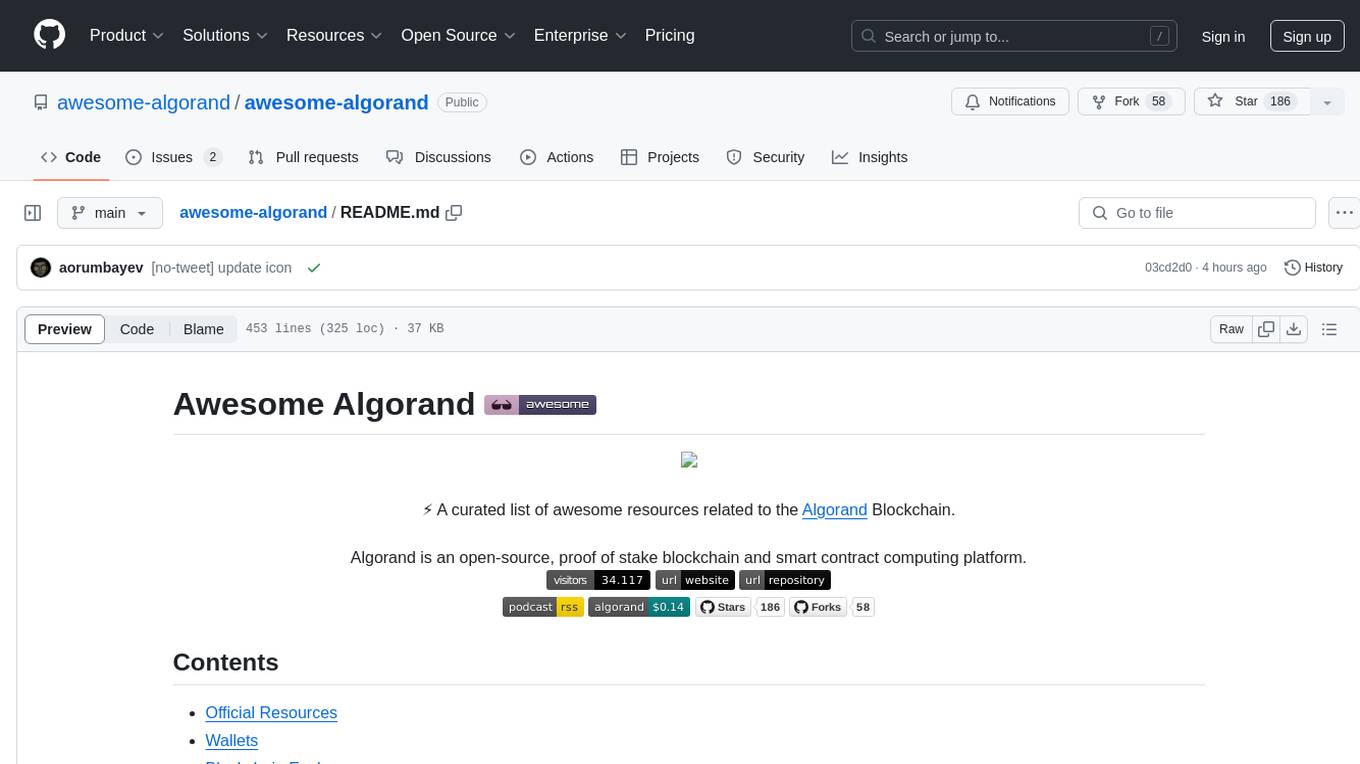
awesome-algorand
Awesome Algorand is a curated list of resources related to the Algorand Blockchain, including official resources, wallets, blockchain explorers, portfolio trackers, learning resources, development tools, DeFi platforms, nodes & consensus participation, subscription management, security auditing services, blockchain bridges, oracles, name services, community resources, Algorand Request for Comments, metrics and analytics services, decentralized voting tools, and NFT marketplaces. The repository provides a comprehensive collection of tools, tutorials, protocols, and platforms for developers, users, and enthusiasts interested in the Algorand ecosystem.
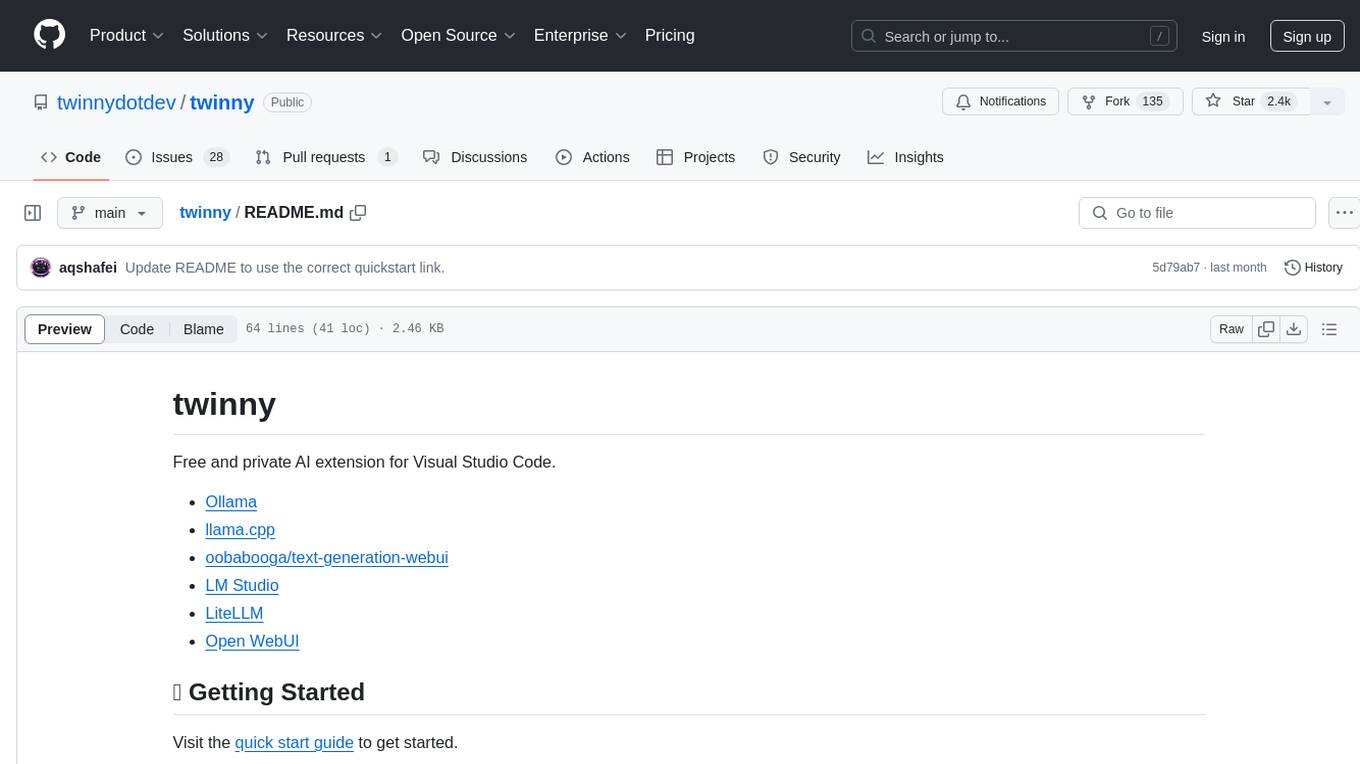
twinny
Twinny is a free and private AI extension for Visual Studio Code that offers AI-based code completion and code discussion features. It provides real-time code suggestions, function explanations, test generation, refactoring requests, and more. Twinny operates both online and offline, supports customizable API endpoints, conforms to OpenAI API standards, and offers various customization options for prompt templates, API providers, model names, and more. It is compatible with multiple APIs and allows users to accept code solutions directly in the editor, create new documents from code blocks, and copy generated code solution blocks. Twinny is open-source under the MIT license and welcomes contributions from the community.
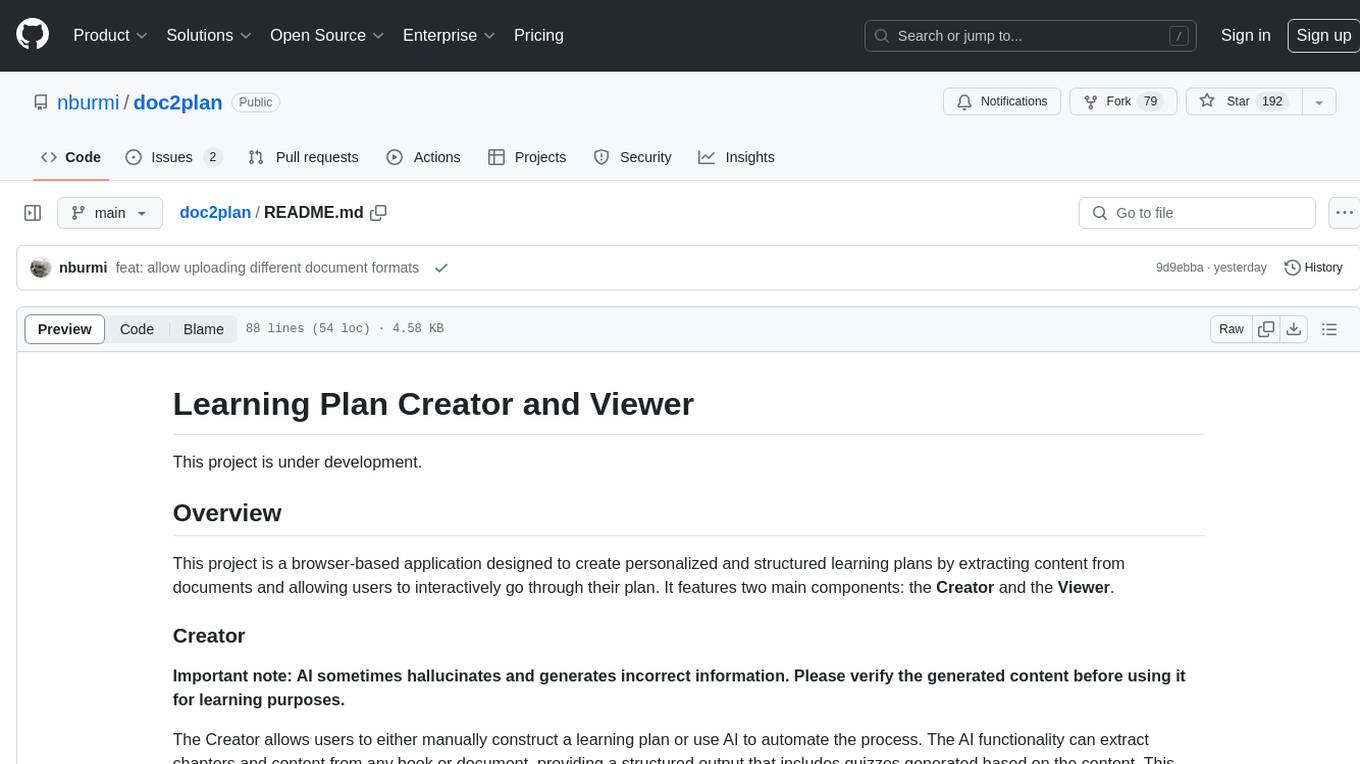
doc2plan
doc2plan is a browser-based application that helps users create personalized learning plans by extracting content from documents. It features a Creator for manual or AI-assisted plan construction and a Viewer for interactive plan navigation. Users can extract chapters, key topics, generate quizzes, and track progress. The application includes AI-driven content extraction, quiz generation, progress tracking, plan import/export, assistant management, customizable settings, viewer chat with text-to-speech and speech-to-text support, and integration with various Retrieval-Augmented Generation (RAG) models. It aims to simplify the creation of comprehensive learning modules tailored to individual needs.
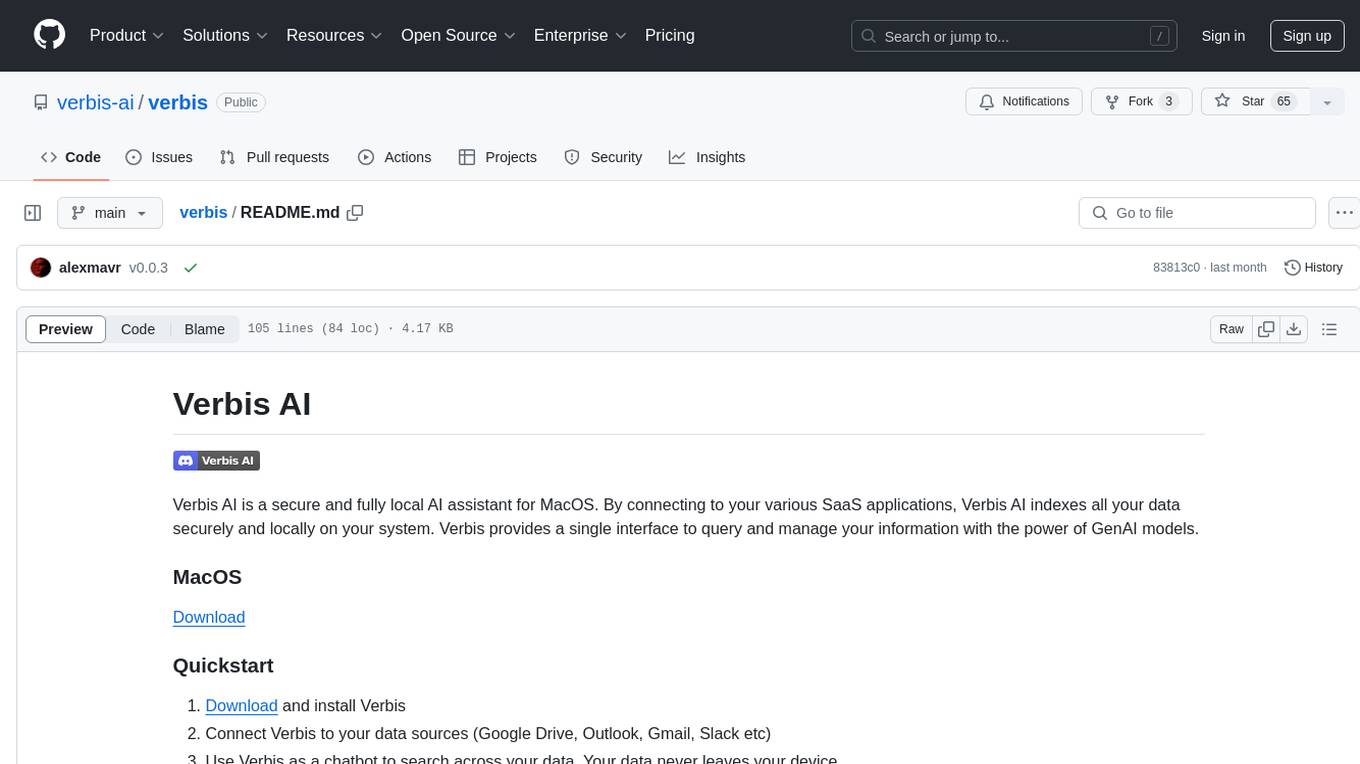
verbis
Verbis AI is a secure and fully local AI assistant for MacOS that indexes data from various SaaS applications securely on the user's system. It provides a single interface powered by GenAI models to query and manage information. Users can connect Verbis to apps like Google Drive, Outlook, Gmail, and Slack, and use it as a chatbot to search across their data without data leaving their device. The tool is powered by Ollama and Weaviate, utilizing models like Mistral 7B, ms-marco-MiniLM-L-12-v2, and nomic-embed-text. Verbis AI requires Apple Silicon Mac (m1+) and has minimal system resource utilization requirements.
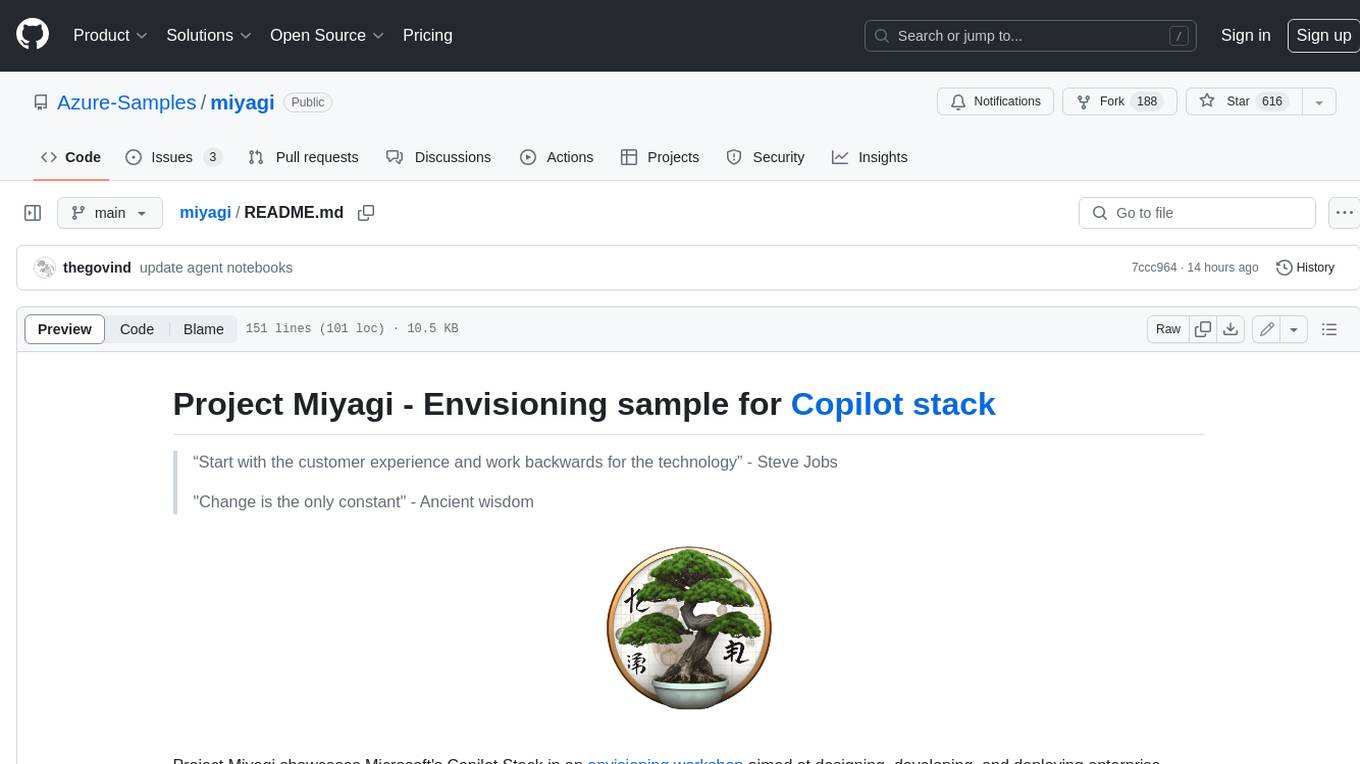
miyagi
Project Miyagi showcases Microsoft's Copilot Stack in an envisioning workshop aimed at designing, developing, and deploying enterprise-grade intelligent apps. By exploring both generative and traditional ML use cases, Miyagi offers an experiential approach to developing AI-infused product experiences that enhance productivity and enable hyper-personalization. Additionally, the workshop introduces traditional software engineers to emerging design patterns in prompt engineering, such as chain-of-thought and retrieval-augmentation, as well as to techniques like vectorization for long-term memory, fine-tuning of OSS models, agent-like orchestration, and plugins or tools for augmenting and grounding LLMs.
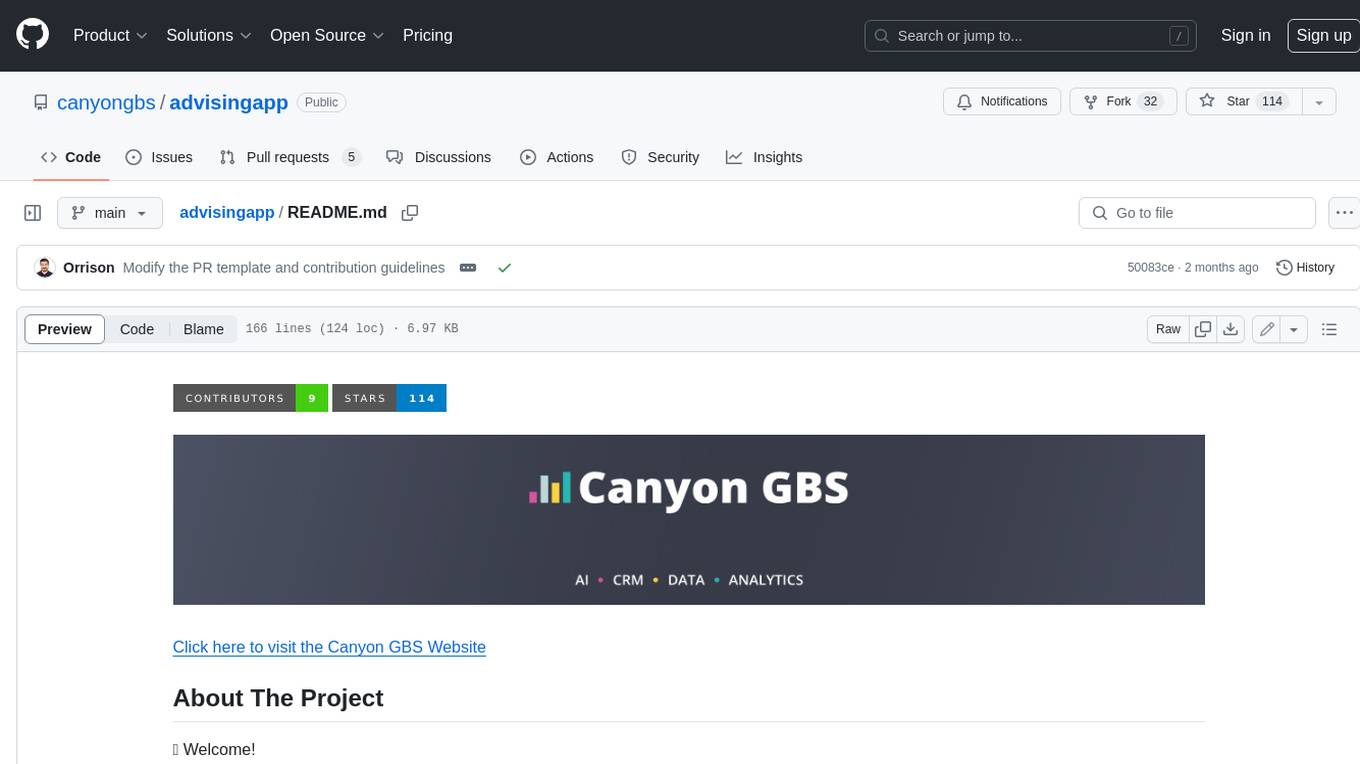
advisingapp
**Advising App™** is a software solution created by Canyon GBS™ that includes a robust personal assistant designed to support student service professionals in their day-to-day roles. The assistant can help with research tasks, draft communication, language translation, content creation, student profile analysis, project planning, ideation, and much more. The software also includes a student service CRM designed to support the management of prospective and enrolled students. Key features of the CRM include record management, email and SMS, service management, caseload management, task management, interaction tracking, files and documents, and much more.
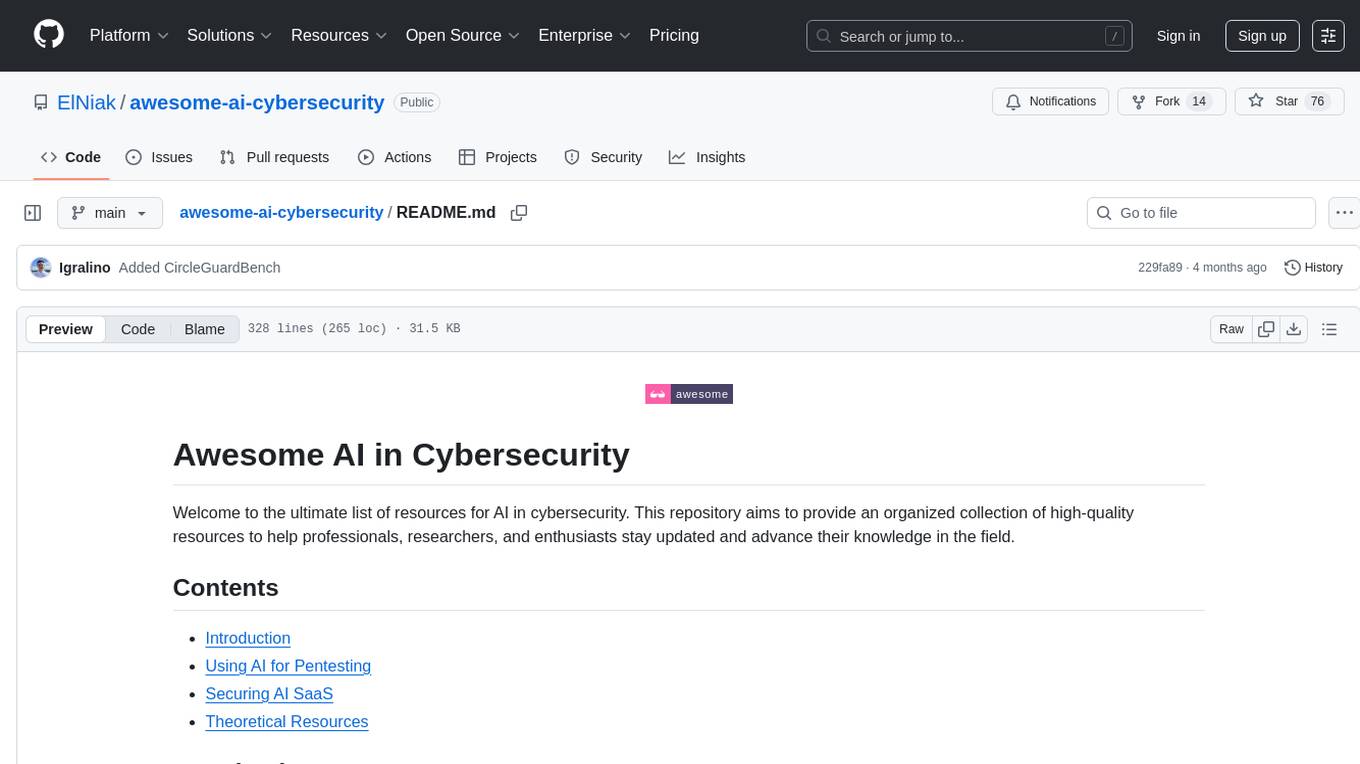
awesome-ai-cybersecurity
This repository is a comprehensive collection of resources for utilizing AI in cybersecurity. It covers various aspects such as prediction, prevention, detection, response, monitoring, and more. The resources include tools, frameworks, case studies, best practices, tutorials, and research papers. The repository aims to assist professionals, researchers, and enthusiasts in staying updated and advancing their knowledge in the field of AI cybersecurity.
For similar tasks

GenAI_Agents
GenAI Agents is a comprehensive repository for developing and implementing Generative AI (GenAI) agents, ranging from simple conversational bots to complex multi-agent systems. It serves as a valuable resource for learning, building, and sharing GenAI agents, offering tutorials, implementations, and a platform for showcasing innovative agent creations. The repository covers a wide range of agent architectures and applications, providing step-by-step tutorials, ready-to-use implementations, and regular updates on advancements in GenAI technology.
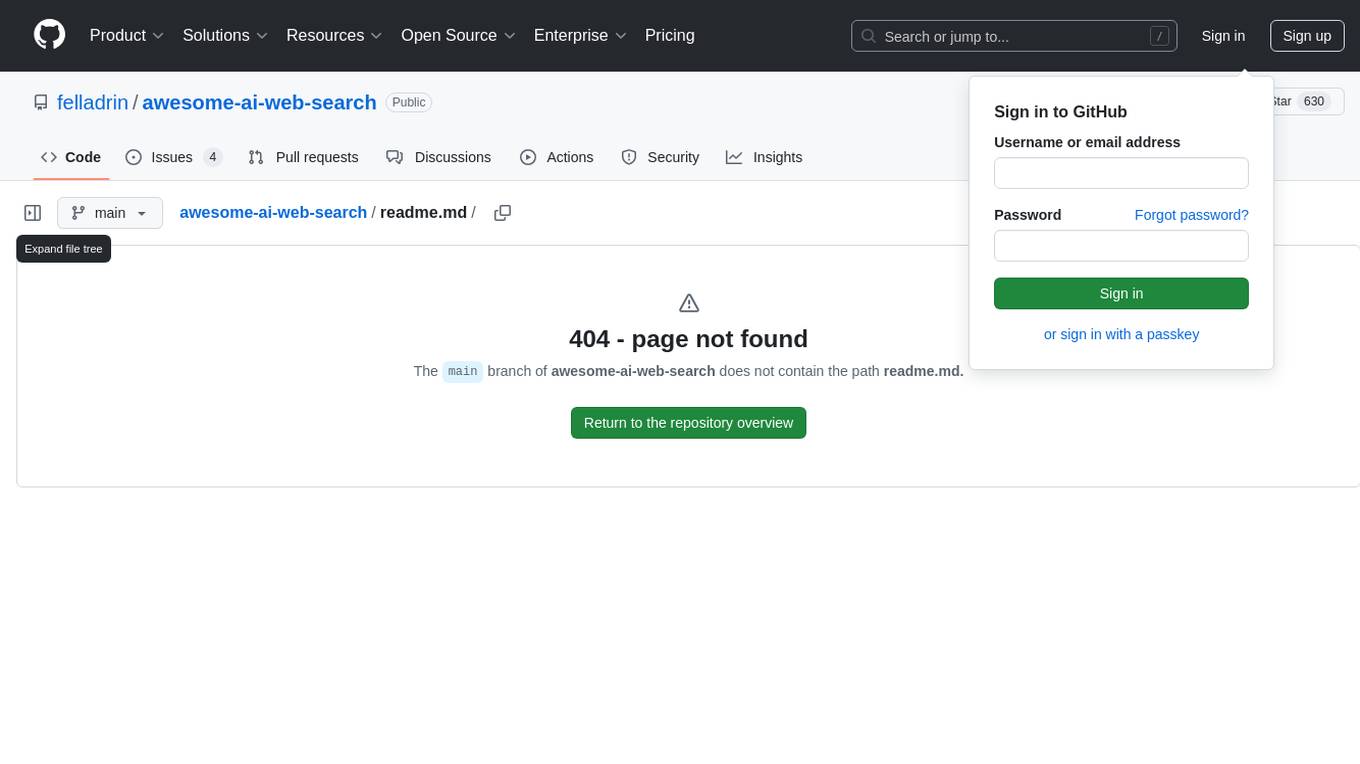
awesome-ai-web-search
The 'awesome-ai-web-search' repository is a curated list of AI-powered web search software that focuses on the intersection of Large Language Models (LLMs) and web search capabilities. It contains a timeline of various software supporting web search with LLM summarization, chat capabilities, and agent-driven research. The repository showcases both open-source and closed-source tools, providing a comprehensive overview of AI web search solutions available in the market.
For similar jobs

promptflow
**Prompt flow** is a suite of development tools designed to streamline the end-to-end development cycle of LLM-based AI applications, from ideation, prototyping, testing, evaluation to production deployment and monitoring. It makes prompt engineering much easier and enables you to build LLM apps with production quality.

deepeval
DeepEval is a simple-to-use, open-source LLM evaluation framework specialized for unit testing LLM outputs. It incorporates various metrics such as G-Eval, hallucination, answer relevancy, RAGAS, etc., and runs locally on your machine for evaluation. It provides a wide range of ready-to-use evaluation metrics, allows for creating custom metrics, integrates with any CI/CD environment, and enables benchmarking LLMs on popular benchmarks. DeepEval is designed for evaluating RAG and fine-tuning applications, helping users optimize hyperparameters, prevent prompt drifting, and transition from OpenAI to hosting their own Llama2 with confidence.
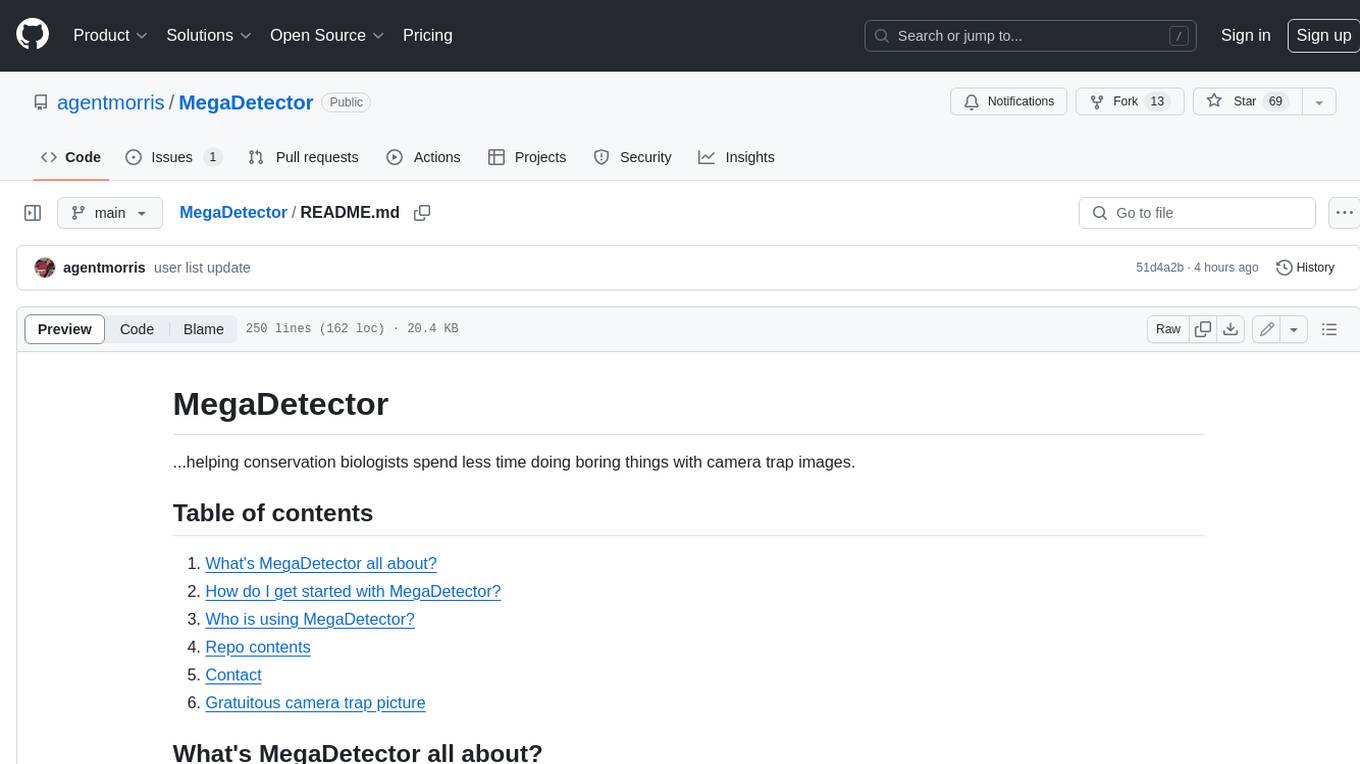
MegaDetector
MegaDetector is an AI model that identifies animals, people, and vehicles in camera trap images (which also makes it useful for eliminating blank images). This model is trained on several million images from a variety of ecosystems. MegaDetector is just one of many tools that aims to make conservation biologists more efficient with AI. If you want to learn about other ways to use AI to accelerate camera trap workflows, check out our of the field, affectionately titled "Everything I know about machine learning and camera traps".

leapfrogai
LeapfrogAI is a self-hosted AI platform designed to be deployed in air-gapped resource-constrained environments. It brings sophisticated AI solutions to these environments by hosting all the necessary components of an AI stack, including vector databases, model backends, API, and UI. LeapfrogAI's API closely matches that of OpenAI, allowing tools built for OpenAI/ChatGPT to function seamlessly with a LeapfrogAI backend. It provides several backends for various use cases, including llama-cpp-python, whisper, text-embeddings, and vllm. LeapfrogAI leverages Chainguard's apko to harden base python images, ensuring the latest supported Python versions are used by the other components of the stack. The LeapfrogAI SDK provides a standard set of protobuffs and python utilities for implementing backends and gRPC. LeapfrogAI offers UI options for common use-cases like chat, summarization, and transcription. It can be deployed and run locally via UDS and Kubernetes, built out using Zarf packages. LeapfrogAI is supported by a community of users and contributors, including Defense Unicorns, Beast Code, Chainguard, Exovera, Hypergiant, Pulze, SOSi, United States Navy, United States Air Force, and United States Space Force.

llava-docker
This Docker image for LLaVA (Large Language and Vision Assistant) provides a convenient way to run LLaVA locally or on RunPod. LLaVA is a powerful AI tool that combines natural language processing and computer vision capabilities. With this Docker image, you can easily access LLaVA's functionalities for various tasks, including image captioning, visual question answering, text summarization, and more. The image comes pre-installed with LLaVA v1.2.0, Torch 2.1.2, xformers 0.0.23.post1, and other necessary dependencies. You can customize the model used by setting the MODEL environment variable. The image also includes a Jupyter Lab environment for interactive development and exploration. Overall, this Docker image offers a comprehensive and user-friendly platform for leveraging LLaVA's capabilities.

carrot
The 'carrot' repository on GitHub provides a list of free and user-friendly ChatGPT mirror sites for easy access. The repository includes sponsored sites offering various GPT models and services. Users can find and share sites, report errors, and access stable and recommended sites for ChatGPT usage. The repository also includes a detailed list of ChatGPT sites, their features, and accessibility options, making it a valuable resource for ChatGPT users seeking free and unlimited GPT services.

TrustLLM
TrustLLM is a comprehensive study of trustworthiness in LLMs, including principles for different dimensions of trustworthiness, established benchmark, evaluation, and analysis of trustworthiness for mainstream LLMs, and discussion of open challenges and future directions. Specifically, we first propose a set of principles for trustworthy LLMs that span eight different dimensions. Based on these principles, we further establish a benchmark across six dimensions including truthfulness, safety, fairness, robustness, privacy, and machine ethics. We then present a study evaluating 16 mainstream LLMs in TrustLLM, consisting of over 30 datasets. The document explains how to use the trustllm python package to help you assess the performance of your LLM in trustworthiness more quickly. For more details about TrustLLM, please refer to project website.
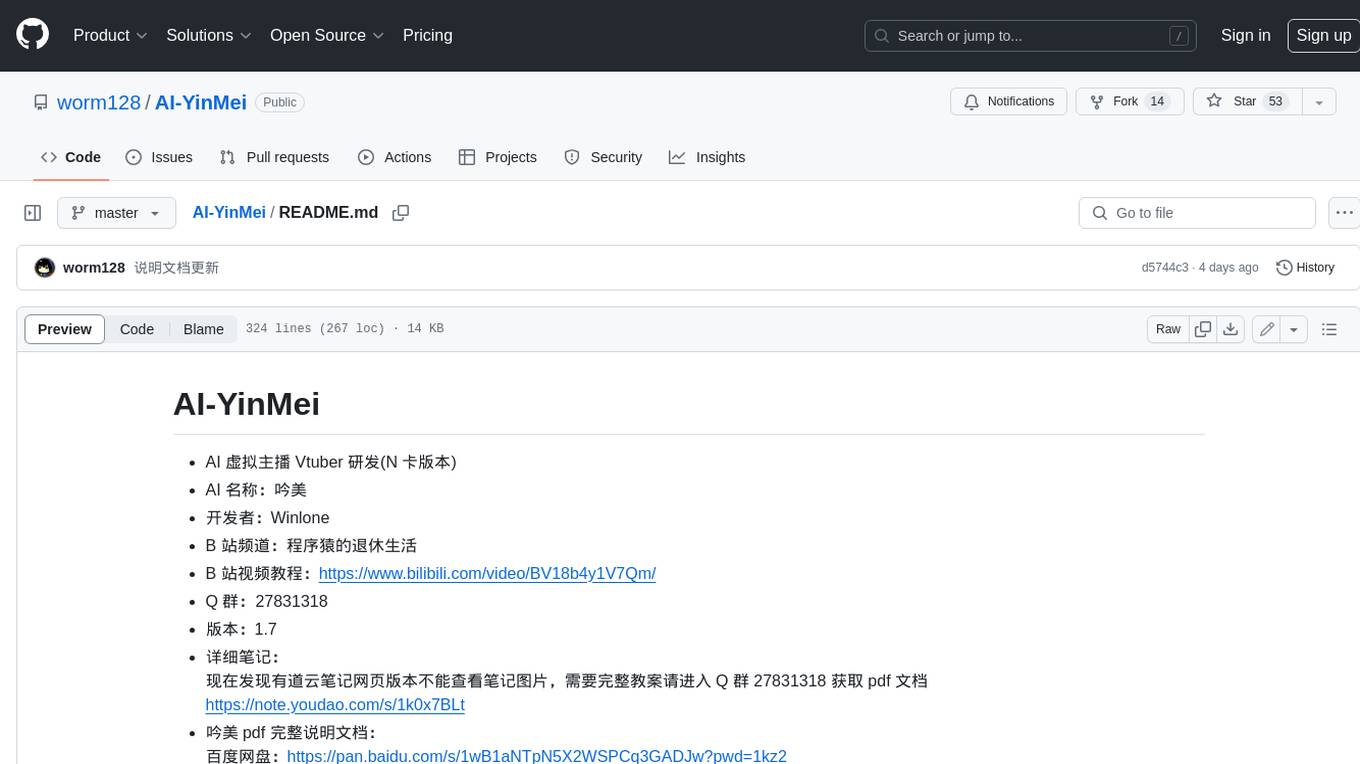
AI-YinMei
AI-YinMei is an AI virtual anchor Vtuber development tool (N card version). It supports fastgpt knowledge base chat dialogue, a complete set of solutions for LLM large language models: [fastgpt] + [one-api] + [Xinference], supports docking bilibili live broadcast barrage reply and entering live broadcast welcome speech, supports Microsoft edge-tts speech synthesis, supports Bert-VITS2 speech synthesis, supports GPT-SoVITS speech synthesis, supports expression control Vtuber Studio, supports painting stable-diffusion-webui output OBS live broadcast room, supports painting picture pornography public-NSFW-y-distinguish, supports search and image search service duckduckgo (requires magic Internet access), supports image search service Baidu image search (no magic Internet access), supports AI reply chat box [html plug-in], supports AI singing Auto-Convert-Music, supports playlist [html plug-in], supports dancing function, supports expression video playback, supports head touching action, supports gift smashing action, supports singing automatic start dancing function, chat and singing automatic cycle swing action, supports multi scene switching, background music switching, day and night automatic switching scene, supports open singing and painting, let AI automatically judge the content.




